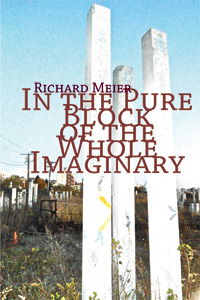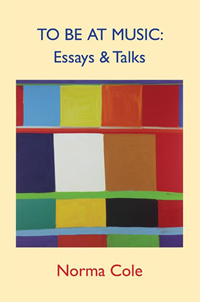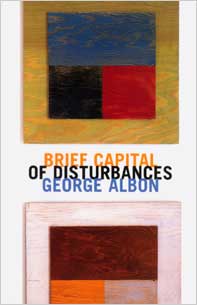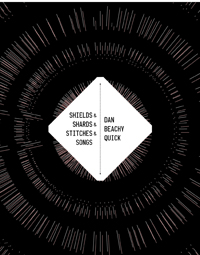Description
In the Pure Block of the Whole Imaginary pushes past the line and the fragment and toward the sentence, the thought trying to complete, the paragraph, a distinct passage. The poems, most a single paragraph, are comprised of several of the many things a paragraph is said to consist of, including, according to the OED: “a distinct passage or section of a text, usually composed of several sentences, dealing with a particular point, a short episode in a narrative, a single piece of direct speech, etc.” The first poem in the project, though no longer the first in the book, was written while reading Francis Ponge’s amazing The Making of Le Pre, which reproduces his notes toward the poem Le Pre alongside a translated type-written transcription. The form of the notes—crammed into every corner of the page, gathering observation, research, reading, quotations, anecdote—suggested a more inclusive way to think and write. The book, with its not-quite 50 prose poems, is also an imaginary completion, an echo or a shadow or shade, of Baudelaire’s planned 100 Petits poèmes en prose. The book, then, became a project only after the fact, or in response to the fact, of the poems’ emergence. The opening of each section—the first few words from each poem in that section—operate as a kind of descriptive table of contents for each section and also a poem of sorts, as those chapter headings often were novels of the past.
With his latest book, Richard Meier takes the New Sentence of the Language Poets and springs its rhythm. In these sturdy blocks of prose the country dapples the city, and by way of overlay and superimposition — of ideas, of images, of sounds — the poet keeps uncovering “that most inescapable of features, a new surface.” Though the word that pops up most frequently is “building,” close runner-ups are “field” and “meadow”: not in opposition to the built world, but as an argument for openness and density, epiphany and nourishment, as cousin kinds of poetic experience. In The Pure Block gives us, in its most burnished form yet, Meier’s gift for mingling them: “Into the pot of all successive seas, the sun dipped like a ladle.”
Chris Nealon, author of The Matter of Capital: Poetry and Crisis in the American Century
“Like opening a door and going into the mountain,” Rick Meier’s effing exceptional new work sings its “e i e i o” from city to country via maypole, all the while “squeezing you…tightly to its side.” Both a poetics & a fellowship, here bodies and sentences revel in chiaroscuro—rainbow is eyebrow, mountain graffitied, and the empire crumbles beside the kids’ & protestors’ protestations. Dealing in presence & even more presence, these generous prose hunks fully occupy their space “far at last from the secret of things” where clouds are perfectly truant children, “a poem is painful,” and we are “happy to be living in the age of ibuprofen, pain pills in general.” This is the fetching, ingenuous, joyful song of a poet, a man, who lives a balanced resistance-acceptance, “present at the very creation of the world.”
Sandra Doller, author of Man Years
The poems in Richard Meier’s In the Pure Block of the Whole Imaginary dissolve into liquid tenderness, slippage, grace, and each is nearly as fragile and complex and impure as the networks and systems we live in, or beside, including those we’ve constructed, like this one, language, such that we are reminded once again that it can be potentialized for plentitude and haptic reverie—a reparative opulence that attends to acts of naming and unnaming as the first ethics of daily life. I feel embraced by this book, by its generosity and brilliance.
Christian Hawkey, author of Ventrakl
About the Author
Reviews
Excerpt
Richard Meier was born in and raised in eastern Massachusetts. Child of public school teachers, he was educated at the Duxbury Public Schools, Hamilton College and Syracuse University. He has worked many jobs over the last 20 years: administrative assistant at the Kwan Um Zen School in Cumberland, RI; director of US Servas, an international peace organization that helps arranges home stays between people of different nationalities; office temp at many Manhattan banks and financial firms, where he was frequently told not even to answer the phone; and as an elementary school assistant teacher and teacher. The first job he held for more than 9 months was as visiting poet in the public schools, beginning with a 5 year stint in New York with Teachers and Writers Collaborative, and most recently in Chicago with the Poetry Center of Chicago’s Hands on Stanzas, where he received the Gwendolyn Brooks Award for Excellence in teaching in 2006. He has also worked and volunteered as a visiting poet in public schools in Virginia, Pittsburgh, and Beloit and Madison, WI. Over the years he has given thousands of children the opportunity to write poetry and had his own writing deeply influenced by the children’s capacity for immediacy, seriousness, and play. In recent years he has taught at Beloit College, Columbia College Chicago, and is currently writer-in-residence at Carthage College in Kenosha, WI. He is the author of two previous books of poetry, Terrain Vague, selected by Tomas Salamun for the Verse Prize, and Shelley Gave Jane a Guitar. He currently lives in Madison and Chicago, where he joins Lisa Fishman and Henry Morren in taking care of and unschooling James Fishman-Morren. According to James, Richard is the P.E., music, and art teacher, with a little poetry thrown in for good measure.
A brief interview with Richard Meier
(conducted by Rusty Morrison)
How/why did you begin In the Pure Block of the Whole Imaginary?
The first poem in the project, though no longer the first in the book, was written while reading Francis Ponge’s amazing The Making of Le Pre, which reproduces his notes toward the poem Le Pre alongside a translated type-written transcription. At the time I was living in the loft of an old granary, now garage, on Lisa Fishman and Henry Morren’s farm. The first sentence—“And in the little meadow, the one Ponge describes in le pre, there was a fire that was meant to trigger an imaginary bomb and succeeded, despite the lies we tell ourselves about where ideas come from.”—in what I was later to recognize as this project was written there and with that book beside me. The form of Ponge’s notes—crammed into every corner of the page, gathering observation, research, reading, quotations, anecdote—suggested a form in which to think all manner of the sources I was hearing at that time. The next fall, after I began to live mainly in Chicago again, eventually I began also to think of the book as an imaginary completion, an echo or a shadow or shade, of Baudelaire’s planned 100 Petits poèmes en prose. The rows became alleys and the economics of vegetation became the economics of detritus, an oscillation that has continued.
These poems suggest to me how many, and how complex, are the competing meanings that we assign objects and events with our focus upon them. I’m amazed by how deftly you provide insight into the multidimensionality of any observation’s possible motion, the fullness of its spectrum and the impact upon us of each coloration. Were these poems difficult to construct?
When I was writing these poems I loved the effort of suspension involved in completing sentences, in hearing the sentences complete over the course of a long string of phrases, the music of the dependent adverbial clause, which seemed to include both openness and closure. And the freedom from the lyric impulse to isolate factors or facts or feelings but at the same time powered by that impulse.
What relationships do you see between the title of the manuscript and the poems?
Mainly one of shape and the relationship one enteres into with shapes, blocks or lakes or fields of clover or pages. I’m sitting at a formica kitchen table, the sort with chrome legs and a gray top that suggests ice crystals or marble. The table came from the basement of that first Chicago apartment, rescued when the building was condemned, and 5 or 7 years later I’m on the top floor of another apartment, on my last morning in it, where the last poems in the book were written, answering this question while a train goes by, as the trains went by the other apartment, and these apartments and this table, which I didn’t find until I left the other apartment, this table and the granary and the train tracks, bookend the book. It’s also true that as I was walking back from the lake a man said, looking down at barefeet, watch out for all the broken glass on the corner. These things are just what happened.
Would you tell me a bit about yourself?
Richard Meier lives alone, or with one adult, or with one child, or with one adult and one child, or with one child and two adults to whom he is not married who are married to each other. Together, the three adults care for and are now unschooling the child, age eight. All of this depends on the season of the year and the day of the week and the social relations and language gaps it exposes are of interest to him in his work. When in Chicago, he likes to walk, along the lakefront and especially in the alleys, which in Chicago are like the streets of an alternate world, where back is front and the rulers are the scrappers in their well-worn pickups.
What, specifically, were some of the most interesting or most daunting challenges you faced as you worked through this text? Were there any unexpected surprises—with respect to form or content—that opened in the text for you in the writing process?
Surprise is one of the measures of what I keep, the sense of the newly actual, new at least to me, so it feels like everything at least wants to be an answer to this question. I was surprised when the sentences were short, after having been long, and long after having been short, and at the relation of what came to seem those two ways of going out into the world.
Who are the authors with whom you feel a kinship? Who are you reading currently?
T. J. Clark and Michael Fried’s writings on art kept reasserting themselves to me as I worked on the book. The Austrian quartet of Peter Handke, Friederike Mayröcker, Thomas Bernhard and Elfriede Jelinek. Viktor Shklovsky. Plus lots of others of course.
You chose the photograph that was used in the cover design for this book. Can you talk about your reasons for this choice?
I arrived early, with James, last fall at Logan airport. Lisa couldn’t come until later, so we stayed in East Boston waiting for her. We spent the afternoon walking around and found along the waterfront a fenced in field full of weeds and rectangular concrete posts of varying heights. I took some pictures and later, thinking of the cover for the book, I decided I wanted an image that came after, and this one suggested itself because of the way the three posts were growing in the weeds, having been abandoned after one or another of the recent collapses. They had the right shape, in other words.
The details of the poems accumulate to create a moving and intricate portrait of the speaker and his surroundings.
Coming after both Ashbery and the practitioners of the New Sentence, this prose retains their trust in a precision without focus, decoupling the fate of the sentence from determination, from the “distortion” of “assigning the flower…a single sensation”; but Meier has relicensed himself to imagine a whole rather than just the drift of the multiple, “attempting to name a network to set against the network” while believing, or wanting to believe, that “[e]very trip to the right margin is a little incursion into the spectacle,” perhaps because it makes its way by refusing to choose “between the statements: between an apparent unity, a thousand dissident style; beneath an apparent dissidence, a thousand unitary styles.”
In the Pure Block of the Whole Imaginary, in the vein of Baudelaire and Rilke but equally of Virginia Woolf and Victor Shklovsky, is a radical departure: an assemblage of untitled prose pieces registering the minute impressions of experience upon consciousness. Crucially, and perhaps because it is in prose, there is no clash between the book’s form and its matter.
A negative construct, the tree in the sun through a tree, the building in they built the building for its space, the space we can still see before exterior walls and windows and a roof. Is it a building yet, steel-forms, concrete, span, and how unlike the human body is this building built at its final scale, adding layers or being layers, the bricklayer with a t-shirt bandanaed around his nose and mouth, the bricklayer below the sky-isn’t-blue-above-this-blue tarp, growth rings of plans and colors. Image of a microscopic building set among life (the book of common flowers with its names and full-page plates) and detritus — mineral, organic, once manufactured — of a wasteland, gestating. At what point in the building is space enviable? Union stickers on a construction helmet (yellow) hanging from a young woman’s backpack. Clothes are constructed from pieces, after the gestation of elements — silk, oil, cotton; we were injected into a mold that can be removed and outlasts what it’s shaping, unlike the wax that makes a single ring with figures out of its own disappearance, nothing created or destroyed but lasts in other forms. Dreams, coral, laws, rock walls, rules, handclaps accumulate.





